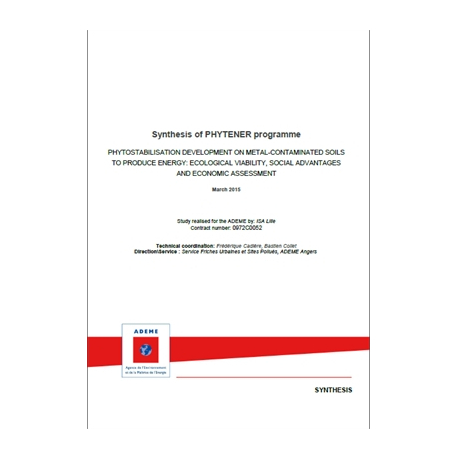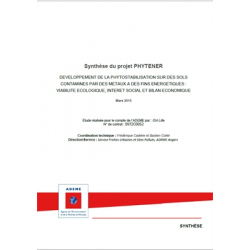 Agrandir l'image
Agrandir l'image
PHYTENER : Phytostabilisation development on metal-contaminated soils to produce energy: ecological viability, social advantages and economic assessment
Neuf
In Northern France, a former lead smelter released large quantities of metal-contaminated dust into the atmosphere for more than a century until its closure in 2003. This atmospheric discharge highly contaminated the soils around the smelter with cadmium (Cd), lead (Pb), and zinc (Zn). In agricultural fields, the contamination is[…]
Plus de détailsFiche technique
| Auteurs | DOUAY F, BIDAR G, ADEME, ISA |
| Public(s) | Secteur de la recherche |
| Thématique | Sols pollués |
| Collection | Hors collection |
| Éditeur(s) | ADEME |
| Date d'édition | 2015/03 |
| Nb. de pages | 32 P |
| Format | pdf/A4 |
| Langue | EN |
| Périmètre de publication | National |
| Régional |
En savoir plus
In Northern France, a former lead smelter released large quantities of metal-contaminated dust into the atmosphere for more than a century until its closure in 2003. This atmospheric discharge highly contaminated the soils around the smelter with cadmium (Cd), lead (Pb), and zinc (Zn). In agricultural fields, the contamination is mainly limited to the ploughed horizon. The crops harvested on soils contaminated with more than 4 and/or 200 mg kg-1 of Cd and/or Pb, respectively, exceed legislation thresholds for food or feedstuff. Overall, this involves 750 ha, which cannot be economically managed by conventional physico-chemical methods. Phytoremediation could be a relevant and an environmentally friendly technique to manage large and highly contaminated sites. To provide scientific and technical arguments on the advantages of phytomanagement, a multidisciplinary research programme, called Phytener and supported by ADEME, was set up in 2009. The management methods were based on Cd, Pb and Zn phytostabilisation, assisted or unassisted, and involved two non-food biomass productions: wood (Robinia pseudoacacia, Alnus glutinosa, Quercus ilex, and Acer pseudoplatanus) and herbaceous vegetation (Miscanthus x giganteus). The programme was expected to assess the sustainability of the proposed management plan and to contribute to a sustainable conversion of agriculture in a disadvantaged area by developing innovative technologies using plant biomass from metal-contaminated soils to produce energy. The aim was to give an economic value to a disqualified farmland to meet environmental, economic and social expectations.



